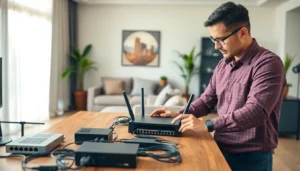Table of Contents
ToggleIn a world where binge-watching and video calls have become our new norms, the importance of a reliable home network can’t be overstated. Imagine a simple flick of the switch that turns your home into a seamless web of connectivity. While many may feel tempted to set things up themselves, investing in professional home networking services might just be the upgrade you never knew you needed. Who knew that getting better Wi-Fi could be more rewarding than getting a new phone? Let’s jump into the ins and outs of home networking to ensure your connectivity dreams become reality.
Understanding Home Networking

Understanding home networking starts with grasping what it truly means. At its core, home networking connects devices to each other and to the internet, allowing them to communicate. This includes everything from computers and tablets to smart home devices like thermostats and lighting, essentially creating a digital ecosystem within the confines of living spaces. These networks can be wired or wireless. Wired networks often use Ethernet cables for speed and reliability, while wireless networks rely on Wi-Fi, offering the convenience of mobility.
Also, maintaining a home network isn’t simply about connecting devices: it also involves managing security, bandwidth, and speed. The more devices connected, the more complex the network becomes, and that’s where the expertise of professionals can come in handy.
Types of Home Networking Services
Home networking services encompass a variety of offerings designed to meet diverse needs. These include:
1. Network Design and Installation
This foundational service involves mapping out the layout of the network, selecting the right equipment, and physically setting up the infrastructure. Whether it’s determining the best placement for routers or strategically utilizing repeaters, professional installers ensure optimal coverage.
2. Wi-Fi Optimization
Just having a Wi-Fi connection doesn’t guarantee good performance. Wi-Fi optimization seeks to enhance speed and connectivity, making sure every corner of the home has strong coverage. This often includes adjusting settings, placing access points, and utilizing mesh networks for extensive homes.
3. Security Services
With the rise of smart devices comes the increased risk of cyber threats. Security services involve setting up firewalls, monitoring traffic, and regular updates to safeguard personal data from hackers. A knowledgeable provider can help ensure your network is under constant protection.
4. Troubleshooting and Maintenance
Even after installation, issues can arise. Troubleshooting services help resolve connectivity problems, be it slow speeds or devices failing to connect. Regular maintenance ensures everything runs smoothly, preventing future headaches.
Benefits of Professional Home Networking Services
Opting for professional home networking services can be a game changer. Here are some notable benefits:
Enhanced Performance
Professional installation typically results in faster and more reliable connections. Expertise in network design minimizes dead zones and ensures optimal use of bandwidth.
Increased Security
With expert guidance, users can carry out security measures that safeguard their data, something often overlooked by DIY enthusiasts, leading to vulnerabilities.
Time Savings
Let’s face it: setting up a home network can be time-consuming and frustrating. Professionals streamline the process, allowing homeowners to focus on what they love instead.
Customized Solutions
Each home is unique. Professionals can create tailored solutions based on specific needs, optimizing everything from speed to device connectivity. This customization often results in a more efficient network, maximizing performance based on individual lifestyles.
Choosing the Right Home Networking Service Provider
Finding the right provider can feel overwhelming, but focusing on a few critical points makes the decision easier.
Expertise
Look for companies with experience in home network setups, those that provide comprehensive services rather than just installation. Customer reviews and testimonials can shed light on reliability and satisfaction.
Support Services
Post-installation support is vital. Providers should offer ongoing maintenance and troubleshooting services to address any future issues.
Transparent Pricing
Ensure all costs are laid out clearly. Some providers bait customers with low initial rates, but hidden fees can quickly inflate the price.
Cross-Device Compatibility
The right provider should be familiar with an array of smart devices, ensuring that the network can support the latest technology without a hitch.
Common Home Networking Issues and Solutions
Even with the best professional setup, issues can crop up. Here are common problems and effective solutions:
Slow Internet Speeds
Multiple devices competing for bandwidth can slow down connections. Solutions include upgrading the router, using Ethernet connections for stationary devices, or adjusting device priorities in network settings.
Limited Coverage
Dead zones may exist in larger homes. Extenders or mesh networks can help by providing additional coverage and eliminating weak spots.
Connection Drops
Interference from other electronic devices or obstructions can lead to dropped connections. Relocating the router and minimizing interference can improve stability.
Security Alerts
If unexpected connection alerts arise, it might indicate a security breach. Regular audits and employing security measures can enhance protection and peace of mind.
Future Trends in Home Networking
The landscape of home networking is shifting rapidly with technological advancements. Here’s what to expect:
Increased Wi-Fi Speeds
Wi-Fi 6 and the upcoming Wi-Fi 7 are set to revolutionize home connectivity, offering faster speeds and improved efficiency, especially in homes with numerous connected devices.
Smart Home Integration
As smart home devices become mainstream, home networks will increasingly support a greater number of IoT devices. Seamless integration will become a priority for networking providers.
Enhanced Security Measures
As cyber threats evolve, so too will security protocols. Expect ongoing developments in network safety, with increased focus on real-time monitoring and adaptive security solutions.




